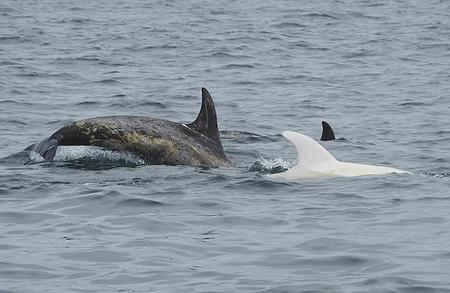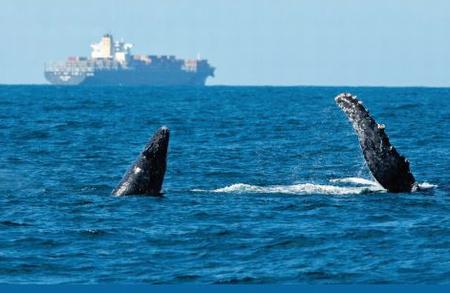
WOODS HOLE, Massachusetts, April 21, 2021 (ENS) – Coronavirus pandemic travel restrictions and economic slowdowns slammed the brakes on human activities in the oceans starting last spring and ongoing. Noise levels are down as cargo ships, cruise ships, and seafloor exploration vessels have slowed or stopped their operations.
The relative silence creates a unique moment for scientists to begin a time-series study of the impacts of human sounds on marine life they have planned for years.
Using hydrophones, microphones that detect sound waves underwater, the study will measure ambient sound in hundreds of ocean locations to reveal variability and changes in intensity at a range of frequencies.
Due to COVID-19, “the oceans are unlikely to be as quiet as during April 2020 for many decades to come,” says project originator Jesse Ausubel, who directs the Program for the Human Environment at The Rockefeller University.
“The COVID-19 pandemic provided an unanticipated event that reduced sound levels more than we dreamed possible based on voluntary sound reductions,” Ausubel said.

(Photo by J. Maughn)
The International Quiet Ocean Experiment (IQOE), launched in 2015, is calling 2020 the Year of the Quiet Ocean and is focusing project resources to encourage study of the changes in sound levels and effects on organisms that occurred in 2020.
The research is based on observations from hundreds of hydrophones deployed by the worldwide ocean acoustics community in 2019-2021.
Of the 231 non-military hydrophones identified to February 2021. Most are in U.S. and Canadian waters, with increasing numbers in Europe. Several operators have agreed to their geographic coordinates and other metadata being shown on the IQOE website https://www.iqoe.org/systems. Organizers hope to attract more contributors.
The existing hydrophone network covers shallow coastal and shelf areas most influenced by local changes in human activity. And it includes deep stations that can measure the effects of low-frequency sound sources over large open ocean areas.
More acoustic instrumentation and measurements are clearly needed across the Southern Hemisphere, the researchers say.
“Measuring variability and change in ambient, or background, ocean sound over time forms the basis for characterizing marine soundscapes,” says collaborator Peter Tyack, a professor of marine mammal biology at the University of St. Andrews, Scotland who heads the university’s Sea Mammal Research Unit.
“Assessing the risks of underwater sound for marine life requires understanding what sound levels cause harmful effects and where in the ocean vulnerable animals may be exposed to sound exceeding these levels,” Tyack said. “Sparse, sporadic deployment of hydrophones and obstacles to integrating the measurements that are made have narrowly limited what we confidently know.”
Tyack co-chairs the IQOE’s Science Committee with Woods Hole Institution Scientist Emeritus in Applied Ocean Physics & Engineering George Frisk.
Frisk is an expert in acoustic propagation, reflection, and scattering in the ocean and along the seafloor; acoustic surface waves; seismo-acoustic ambient noise; and arctic acoustics.
New software under development by a team of researchers across the country led by the University of New Hampshire will soon help standardize ocean sound recording data from collaborators, facilitating its comparability, pooling and visualization. From April 8, the new MANTA software is available at https://bit.ly/3cVNUox)
“Integrating data on animal behavior on soundscapes can reveal long-term effects of changes in ocean sound,” says Jennifer Miksis-Olds, director of the Center for Acoustics Research and Education, University of New Hampshire.
As well, an Open Portal to Underwater Sound, OPUS, is being tested at Alfred Wegener Institute in Bremerhaven, Germany, to promote the use of acoustic data collected worldwide, providing easy access to MANTA-processed data.

The fledgling hydrophone network will continue contributing to the Global Ocean Observing System, a worldwide collaboration of observing devices monitoring currents, temperature, sea level, chemical pollution, litter.
Edward R. Urban Jr, IQOE manager of the Scientific Committee on Oceanic Research, is concerned that the window of quiet monitoring will end too soon. “To observe a return to normal conditions as the pandemic subsides,” he said, “the intensive acoustic monitoring by many existing hydrophones must continue at least through 2021.”
IQOE hydrophone contributors will have plenty to listen to according to the Swiss nonprofit Ocean Care, whose new campaign, Silent Oceans, works to inform the public that levels of human-generated noise in the ocean have roared ahead over the last 60 years, doubling every decade.
Some of the most damaging sources of underwater noise are:
Explosives: Explosives are detonated in the ocean on a regular basis by military forces, scientists, and the oil and gas industries.
Airguns: Seismic airguns are used for oil and gas exploration purposes, and the sound reverberations they give off can penetrate thousands of meters into the ocean before heading deep into the planet’s crust.
Wind Power Development: With the offshore wind industry expanding around the world, a new study from the Woods Hole Oceanographic Institution raises questions about how the noise from impact pile driving to install turbine supports is affecting marine life.
Military Sonar: Military forces use low- and mid-frequency sonar in the ocean to detect objects such as hostile submarines. These sonar frequencies, which can hit 230 decibels, emit pulses of sound for over 100 seconds at a time, for hours without stopping.
Shipping Traffic: Over 90 percent of the global transportation of goods involves commercial shipping vessels. The swiss nonprofit Ocean Care says that these vessels “are generating an ever-present and constantly rising acoustic fog that masks natural sounds and is the most common source of ocean noise along with seismic airguns.”
From Rockefeller University, Ausubel says consistent monitoring is key, and he extends an invitation to all hydrophone operators to get involved with IQOE monitoring. “We invite parties in a position to help to join this global effort on the variability and trends of ocean sound and the effects of sound on marine life,” he said. “The shocking global effect of COVID-19 on human additions of noise to the oceans can spur maturation of regular monitoring of the soundscape of our seas.”
Featured Image: Cargo ship engulfs whales with noise somewhere on the high seas. (Photo courtesy International Whaling Commission)
© 2021, Environment News Service. All rights reserved. Content may be quoted only with proper attribution and a direct link to the original article. Full reproduction is prohibited.
